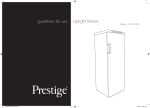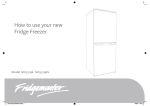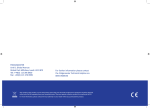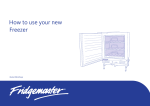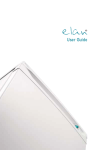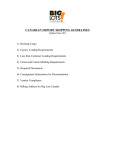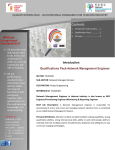Download Fridge Freezer
Transcript
PRESTIGE Instructions for use Model PRT295FFCS PRT325FFCS guidelines for use PRT 295/325 FFCS D6.indd 1 Fridge Freezer Model PRT 295 FSCS Model PRT 325 FSCS 1/12/06 16:32:46 2 GETTING TO KNOW YOUR FRIDGE FREEZER Location Before use Please read these instructions carefully before using your new Prestige Fridge Freezer The Fridge Freezer is for indoor and domestic use only. CONTROL PANEL FRIDGE INSTALLATION CONTROL PANEL FREEZER INTERNAL LIGHT When selecting a position for your Fridge Freezer you should make sure the floor is flat and firm, and the room is well ventilated with an average room temperature of between 16°C and 32°C. Avoid locating your Fridge Freezer near a heat source, eg. cooker, boiler or radiator. Also avoid direct sunlight. If you are placing your Fridge Freezer in an out-building such as a garage or annex ensure that the Fridge Freezer is placed above the damp course, otherwise condensation will occur on the Fridge Freezer cabinet. Never place the Fridge Freezer in a wall recess or into fitted cabinets or furniture. It must be installed so that there is 10mm of free space at the sides, 30mm above and 50mm behind. The Fridge Freezer door can either open to the right or the left, depending on the location which suits you. See page 7 if you want to reverse the door swing. Do not drape the Fridge Freezer with any covering. Levelling the Fridge Freezer The Fridge Freezer has 2 adjustable feet at the front and 2 castors at the back to assist with moving. Once the Fridge Freezer is put in it’s final location, make sure it is level. Use the levelling feet at the front. If the Fridge Freezer is not level, the doors and magnetic seal alignments will be affected. ADJUSTABLE SHELVES Cleaning before use SALAD BIN EGG TRAY FREEZER BASKETS Wipe the inside of the Fridge Freezer with a weak solution of bicarbonate soda. Then rinse with warm water using a ‘wrung-out’ sponge or cloth. Wipe completely dry before replacing the shelves and baskets. You could clean the Fridge Freezer externally with wax polish. If you require more information refer to CLEANING on page 8. Before plugging in YOU MUST SPARE BRACKET DOOR CHANGE Check that you have a socket which is compatible with the plug supplied with the Fridge Freezer. If not, see the section called ELECTRICAL CONNECTIONS on page 11. Before switching on! LEVELLING FEET DO NOT SWITCH ON UNTIL FOUR HOURS AFTER MOVING THE FRIDGE FREEZER. The coolant fluid needs time to settle. BOTTLE STORAGE DOOR HANDLE Before using your Fridge Freezer Before placing frozen foods in your freezer, turn the Fridge Freezer on and wait for 24 hours, to make sure it is working properly and to allow the freezer to reach the correct temperature. If you are freezing fresh foods, see Super freeze, in the section called ‘Indicator Lights’ on page 3/4. Always follow the storage instructions on the food packaging. Your freezer baskets should not be over filled. PRT 295/325 FFCS D6.indd 2 1/12/06 16:32:48 3 INSTALLATION Attaching the handle to the door The handle is shipped inside the baskets in your Fridge Freezer. To fix it: 1. Remove blanking caps from door on the side which opens. USING YOUR FRIDGE FREEZER Switching on your Fridge Freezer Is the freezer cold enough? Freezer alarm If you are concerned that your freezer is not being kept cold enough, and wish to check the temperature, you will need a special fridge / freezer thermometer available from most supermarkets and hardware shops. Place the thermometer in the middle basket of the Freezer, where it can be read easily. Leave overnight, the temperature in the Freezer should be -18°C or lower. When the unit is plugged in you will hear a beep and the display panel will light up. After a few seconds the display will show the temperature in both the refrigerator and freezer. The display temperature and alarm indicator will flash. When the appliance is turned on it will go through internal checks. The Freezer alarm may flash until the temperature falls below -10ºC. During this period the alarm can be cancelled by pressing and holding the alarm/M button. If the constant internal temperature in the freezer rises to -10ºC or above the alarm indicator light will glow. Adjusting the temperature 2. Secure the handle in place using the screws provided. 3. Cover the screw heads using the blanking caps provided with the handle. To change the internal temperature of the Fridge Freezer use the up down buttons on the control panel. The recommended operating temperature for the Fridge section of your Fridge Freezer is 2 and 5ºC. The recommended operating temperature for the Freezer section is -18°C or lower. Additional Feature The Fridge Freezer may not operate at the correct temperature if it is in a particularly hot or cold room or if you open the Fridge Freezer doors often. Super cool/Super freeze light - green REFRIGERATOR Your freezer compartment can be used as either a freezer or extra refrigeration space. Indicator lights This light shows when the Super cool/Super freeze button has been pressed. SUPER FREEZER INDICATOR Super cool ON/OFF Super cool Temp REFRIGERATOR FREEZER Super freeze Super Super cool cool ON/OFF Super cool FREEZER Temp Super freeze ON/OFF Alarm/M Super cool/Super freeze buttons F Alarm Temp SUPER COOL INDICATOR Temp Super freeze ON/OFF Alarm/M F ALARM INDICATOR If all the above are in order, the green lamp bulb may have blown. Call your Customer Service Department if this is the case. See page 8 for details. This allows you to drop the temperature to its lowest setting and return automatically to the pre-set temperature PRT 295/325 FFCS D6.indd 3 1/12/06 16:32:51 4 USING YOUR FRIDGE FREEZER Noises inside the Fridge Freezer Salad bin If you have not owned a Refrigerator before, you may notice that it makes some rather unusual noises. Most of these are perfectly normal. Gurgling, whooshing These noises are caused by the circulation of the refrigerant liquid in the cooling system. It has become more pronounced since the introduction of CFC free gases. This is not a fault and will not affect the performance of your Fridge Freezer. This is the compressor motor working, as it pumps the refrigerant around the system. Door alarm If the Fridge Freezer door is left open, after a period of approximately 2 minutes the door alarm will sound to remind you to close the door. The alarm will continue to sound 3 times every 30 seconds If the door is not closed, after around 10 minutes the alarm will automatically stop. When you store foods in the refrigerator compartment Cool area • • • • • By pressing the Super cool button the fridge will operate in Super cool mode and the Super cool indicator light will be on. The compressor will work continuously or until the internal temperature reaches +1°C, at which point it will automatically stop. You can override this function by pressing the Super cool button again during this cycle. Shopping for chilled foods Don’t buy in your lunch hour! Unless you have a Fridge Freezer at work to keep the food cold in the afternoon. Leaving food in your car or at room temperature for a prolonged period of time could raise food temperature to the level at which harmful bacteria grow. Tips for keeping food perfect in the Fridge Freezer Take extra care with meat and fish Cooked meats should always be stored on a shelf above raw meats to avoid bacterial transfer. Keep raw meats on a plate which is large enough to collect juices and cover it with cling film or foil. Leave space around food This will allow cold air to circulate around the Fridge Freezer. Wrap up food To prevent transfer of flavours and drying out, food should be separately packed or covered. Let pre-cooked food cool properly Always let pre-cooked food cool down before you put it in the Fridge Freezer. This will stop the internal temperature of the Fridge Freezer from rising. Shut the door To prevent cold air escaping, limit the number of times you open the door. When returning from shopping, sort foods to be kept in your Fridge Freezer while the door is closed. Keep chilled foods together COOL COLDEST COOL Raw and uncooked foods should always be wrapped. Pre-cooked chilled foods, eg. ready meals, meat pies, soft cheeses. Pre-cooked meats eg. ham. Prepared salads (including pre-washed chopped, pre-packed mixed green salads, rice, potato salad etc). Desserts, eg. fromage frais, home-prepared food and leftovers or cream cakes. PRT 295/325 FFCS D6.indd 4 NOTE: ALWAYS WRAP AND STORE RAW MEAT, POULTRY AND FISH ON THE LOWEST SHELF AT THE BOTTOM OF THE FRIDGE. THIS WILL STOP THEM DRIPPING ONTO, OR TOUCHING OTHER FOODS. DO NOT STORE INFLAMMABLE GASES OR LIQUIDS IN THE FRIDGE. Super cool button Humming, purring or pulsating The circulation fan (inside the top of the cavity) is designed to assist a more even temperature range across all the shelves. However, we recommend that you follow the guidelines below: This is the most humid part of the Fridge. Store vegetables, fruit, fresh salad items, eg. unwashed whole lettuce, whole tomatoes, radishes, etc here. WE RECOMMEND THAT ALL PRODUCE KEPT IN THE SALAD BIN IS WRAPPED. When you are going around the supermarket and when you are travelling home. If you keep all the chilled foods together they will help to keep each other cold. Use a cool bag Special insulated bags can be bought from most supermarkets and hardware shops. These keep food cold for longer, but are only for getting chilled foods home, not storing it. Unpack as soon as you get home Always unpack and place chilled foods in the Fridge Freezer before storing dry food-stuffs. 1/12/06 16:32:52 5 USING YOUR FRIDGE FREEZER Shopping for frozen foods Your freezer is 4 star ★ ★ ★ ★ When you are buying frozen food, look at the Storage Guidelines on the packaging. You will be able to store each item of frozen food for the period shown against the 4 star rating. This is usually the period stated as ‘Best Before’, on the front of the packaging. Store food straight away Don’t buy frozen food unless you can freeze it straight away. Special insulated bags can be bought from most supermarkets and hardware shops. These keep frozen food cold for longer. Thawing frozen food Check the temperature of the frozen food cabinet in the shop where you buy your frozen foods. It should show a temperature lower than -18°C. For some foods, thawing before cooking is unnecessary. Vegetables and pasta can be added directly to boiling water or steam cooked. Frozen sauces and soups can be put into a saucepan and heated gently until thawed. Making ice cubes Preparations for freezing Check the freezer temperature At the top of the freezer cabinet there is a section for making and storing ice cubes. Fill the ice cube tray with fresh drinking water and place in the section for making and storing ice cubes. After the ice cubes are made you can remove them from the tray by twisting the tray slightly and or placing the tray under running water for a short time. • • • • • Choose packs carefully Take a quick look at the frozen food package and make sure it is in perfect condition. Purchase frozen food last Always buy frozen products last on your shopping trip or visit to the supermarket. Keep frozen foods together When you are going around the supermarket and when you are travelling home, if you keep all the frozen foods together they will help to keep each other cold. PRT 295/325 FFCS D6.indd 5 • • • Leave cooked food to cool completely. Chill food in a fridge before freezing if possible. Consider how you want to cook the food before freezing it. Don’t freeze food in metal containers as you may want to microwave it straight from the freezer. Use special freezer bags available from supermarkets, freezer film, polythene bags, plastic containers, aluminium foil (heavy grade only, if in doubt, double wrap). Don’t use aluminium foil for acidic foods (such as citrus fruits). Don’t use thin cling film or glass. Don’t use used food containers (unless cleaned thoroughly first). Exclude as much air from the container as possible. You could buy a special vacuum pump which sucks excessive air out of the packaging. Leave a small amount of ‘air space’ when freezing liquids, to allow for expansion. You can use the space in the freezer most efficiently if you freeze liquids (or solids with liquids, such as stew) in square blocks. This is known as ‘preforming’. Pour the liquid into a polythene bag which is inside a square sided container. Freeze it like this, then remove it from the container and seal the bag. Freezing fresh foods The golden rules Use quality food and handle it as little as possible. Freeze food in small quantities, it freezes faster, takes less time to thaw and enables you to eat it in the quantity you need. Using the Super freeze button First, estimate the amount of food you will be freezing. Your freezer has a Super freeze button (see Indicator lights on page 3/4) which makes your freezer colder (approx -28° C), it will therefore freeze quicker and keep in the goodness. However you should use it sparingly to conserve energy. To freeze Super freeze A loaf of bread A small casserole Not required Up to 2lb/900gm 2 hrs before placing food in freezer and 4 hrs after placing food in freezer Up to 6lb/2.7kg 6 hrs before placing food in freezer and 12 hrs after placing food in freezer Maximum of 22lb/10kg 24 hrs before placing food in freezer and 24 hrs after placing food in freezer What not to freeze Bananas, pomegranates, pears, carbonated liquids as they can explode or anything in a glass container, as these may crack. NOTE Do not store inflammable gases or liquids in the freezer. 1/12/06 16:32:53 6 USING YOUR FRIDGE FREEZER Freezing fresh foods Useful tips • • • • • • • • • The freezer will fast freeze your produce successfully but cannot improve it. Carefully clean and prepare each item and wrap in polythene or place in waxed cartons. Keep the size of each package to a minimum. Do not forget that square packages will utilise the storage space of your freezer more effectively. Freeze each package as quickly as possible. Produce to be frozen should be placed in as much contact as possible with the sides of the freezer. Avoid placing unfrozen food in contact with food previously frozen. Do not overload the freezer with fresh produce. The maximum amount of fresh produce that can be frozen in 24 hours is 5 kilograms. Frozen food should be used in rotation and therefore packages should be carefully labelled. Lower the temperature in the freezer to maximum 24 hours before the desired freezing is to be effected. After this period the appliance will be ready to freeze the fresh produce. 24 hours after putting in the fresh produce the freezing operation should be completed, you may then return the thermostat to the normal position. Commercially frozen pre-packed food should be stored in accordance with the frozen food manufacturers’ instructions. To thaw 1. Cover food loosely. 2. Thaw at room temperature. Don’t forget that thawing in a warm area encourages the growth of bacteria. 3. Always make sure there are no ice crystals in the food before cooking, particularly with meat. These crystals indicate that the food is not fully thawed. They result in lower temperatures when cooking. Lower cooking temperatures may not destroy dangerous bacteria. 4. Cook food as soon as possible after thawing. 5. Drain off and throw away any liquid lost during thawing. Oven thawing Many microwaves and ovens have thaw settings. To avoid bacterial build up, only use these if you intend to cook the food immediately afterwards. PRT 295/325 FFCS D6.indd 6 Safety tips • • Never re-freeze anything that has thawed out unless you cook it again, to kill off harmful bacteria. Never re-freeze thawed shellfish. Useful tip Re-seal packs properly after removing items. This prevents drying or ‘freezer burn’ and a build up of frost on any remaining food. Label everything • • • Many foods look the same when frozen, so careful labelling will help avoid forgetting what an item is. Storage times being exceeded could cause food poisoning. You can buy special freezer tape for use in low temperatures. This tape is available in white, so you can use it to write the items contents on. You can buy special freezer labels and pens. Labels come in different colours which can help you use your freezer effectively. For instance you could colour code meat red and vegetables green. Using a different colour label for each quarter of the year will help you rotate your frozen food more efficiently. Write the contents and date. If you are really organised add the weight and notes on cooking such as ‘thaw first’, or ‘cook from frozen’ and keep a separate ‘log-book’ of what is in each drawer. This will save opening the door and searching around unnecessarily. Recommended Storage Periods (when frozen from fresh) Fruit Syrup or Sugar packed Fruit up to 12 months Open Frozen or Puréed Fruit up to 18 months Fruit juices up to 6 months Beef up to 10 months Lamb up to 10 months Veal up to 6 months Pork up to 6 months Minced meat up to 3 months Cured meats up to 2 months Sausages up to 3 months Packed bacon up to 3 months Smoked bacon/ chops/ gammon steaks up to 2 months Unsmoked bacon/ chops/ gammon steaks up to 1 month Chicken up to 8 months Duck up to 5 months Goose up to 5 months Turkey up to 6 months White fish up to 5 months Oily fish including salmon up to 2 months Smoked salmon up to 3 months Caviar don’t freeze Shellfish up to 1 month Butter up to 6 months Cheese up to 6 months Cream - double/ whipping up to 3 months Eggs - only freeze separated up to 10 months Suet up to 6 months Milk up to 1 month Yogurt up to 6 weeks 1/12/06 16:32:54 7 REVERSING THE DOOR SWING Both the door of the fridge and the freezer can be reversed. • Ensure the Fridge Freezer is unplugged and empty. • We recommend you have someone to assist you. 1 2 3 Tools required • Phillips style screwdriver • Flat bladed screwdriver • An 8mm socket or spanner and 10mm socket or spanner. When laying the Fridge Freezer on its back in order to gain access to the base, you should never tip it back by more than 45º. Rest it on soft foam packaging or similar material to avoid damaging the cooling pipes at the rear of the Fridge Freezer. 4 Remove pin with a 10mm spanner/socket, replace on the other side. Remove the door. 8 Remove the bottom bracket using an 8mm socket or spanner. Remove the blanket plates from the opposite side. PRT 295/325 FFCS D6.indd 7 Remove the three screws at the rear of the Fridge Freezer and the two screws on the top lid and remove the lid. 5 Remove the middle hinge bracket using an 8mm socket or spanner. Lift away the bottom door. 9 Secure the replacement botom bracket (shipped in the salad drawer of the Fridge Freezer) on the opposite side of the fridge. Replace the door and secure the middle bracket on to the Fridge Freezer. Use an 8mm spanner to remove the bolts from the top bracket and lift the bracket out of the recess in the door. 6 Remove the bolts on the other side of the Fridge Freezer and replace where the bracket has been removed. 7 Remove the hinge holder from the top of the door and replace on the other side. Repeat for the bottom door. Remove the blanking plates and screw cover. Remove screw and replace screw on the opposite side. 10 11 Check both doors are aligned horizontally and vertically, and that the seals are closed on all sides before finally tightening the bottom hinge. Insert top hinge into the recess on top of the door. Bolt into place using the three bolts removed earlier. 1/12/06 16:32:59 8 CLEANING Cleaning inside the Fridge Freezer Clean the Fridge Freezer internally with a weak solution of bicarbonate of soda. Then rinse with warm water using a ‘wrung-out’ sponge or cloth. Wipe the Fridge Freezer dry before replacing the baskets and shelves. You can remove and clean the drainage which is located at the back of the fridge compartment, above the salad drawers. This can get blocked and affect the fridge’s automatic defrost function. Wash in warm soapy water and rinse under a running tap to clear any blockages, wipe dry and replace. Wash the baskets and shelves in warm soapy water. Ensure they are completely dry before replacing in the Fridge Freezer. MAINTENANCE Moving your Fridge Freezer Changing the internal light Do not locate your Fridge Freezer near a heat source, eg. cooker, boiler or radiator. Also avoid direct sunlight. 1. Before carrying out the bulb replacement always switch off and disconnect the electrical supply. 2. Slide the cover off the light. 3. Remove the old bulb by unscrewing in an anti-clockwise direction. Location Levelling the Fridge Freezer Make sure the Fridge Freezer is level. Use the rotating levelling feet at the front. If the Fridge Freezer is not level, the doors and magnetic seal alignments will be affected. Do not turn on the Fridge Freezer for 4 hours After the Fridge Freezer is in place it needs to be left for 4 hours. The coolant fluid needs time to settle. Installation Don’t cover or block the vents or grilles of your appliance. Servicing Repairs and maintenance of the appliance should only be performed by an authorised, qualified technician. 4. Replace with a new bulb (10w) by screwing it in a clockwise direction making sure that it is secure in the bulb holder. 5. Replace the light cover back into position and click back into place. 6. Re-connect your Fridge Freezer to the electrical supply and switch on. After Sales Service Cleaning the outside of the Fridge Freezer Use standard furniture polish to clean the Fridge Freezer exterior. Make sure that the doors are closed, to prevent polish getting on the magnetic door seal or inside. The grille of the condenser at the back of the Fridge Freezer and the adjacent components can be vacuumed using a soft brush attachment. PRT 295/325 FFCS D6.indd 8 If you experience a problem with your appliance and you require advice please contact the technical help line on 0113 2793520 Please note: You can not book a Service call on this number. If you require a Service enginneer to call the number is 0870 5425425 1/12/06 16:33:01 9 TROUBLESHOOTING TECHNICAL SPECIFICATIONS The Fridge Freezer is not working Model PRT 295 FSCS Model PRT 325 FSCS Check it is plugged in and switched on. Check that the fuse in the plug has not blown. Plug in another appliance, such as a lamp, to see if the socket is working. The Fridge Freezer should be placed in a well ventilated room with an ambient temperature of between 16°C and 32°C. Rated Voltage (V) 220-240 Rated Voltage (V) 220-240 Rated Frequency (Hz) 50 Rated Frequency (Hz) 50 Energy Class A Energy Class A Fridge Gross Volume (Litres) (Cubic Feet) 263 9.3 Fridge Gross Volume (Litres) (Cubic Feet) 302 10.7 Freezer Gross Volume (Litres) (Cubic Feet) 121 4.3 Freezer Gross Volume (Litres) (Cubic Feet) 121 4.3 Red warning light glows continuously If you have recently turned your Fridge Freezer on for the first time, it may take up to 12 hours to cool to the correct operating temperature. If it stays on longer, call your Customer Service Department. Condensation on the outside of the Fridge Freezer This may be due to a change in the room temperature. Wipe off any residue of moisture. If the problem continues call your Customer Service Department. Noises You may hear some unusual noises from time to time. See ‘Noises inside the Fridge Freezer’ on page 4. The mains power green light goes off • • Check the power and that the Fridge Freezer is plugged in. Check that the thermostat control isn’t at 0. Tips If the Fridge Freezer won’t be used for a long period of time switch it off, unplug and clean it. Leave the door open to prevent the formation of mildew and smell. Power cut If the internal temperature of the freezer compartment is -18°C or less when the power returns, your food is safe. The food in your Fridge Freezer will remain frozen for approx 16 hours with the door closed. If you know the power is going to be cut, turn the Super freeze button on, 24 hours before, this will make the Fridge Freezer colder than normal. If there is no warning, use the Super freeze button after the power cut. Don’t open either of the Fridge Freezer doors more than necessary. PRT 295/325 FFCS D6.indd 9 Weight (Kg) 82 Weight (Kg) 86 Product Dimension h/w/d (cm) 183.4 / 59.5 / 66.4 Product Dimension h/w/d (cm) 196 / 59.5 / 66.4 Star Rating 4 Star Star Rating 4 Star Sound Decibel Rating (dB[A]) 42.5 Sound Decibel Rating (dB[A]) 42.5 Climate class N Climate class N Ambient temperature range 16-32ºC Ambient temperature range 16-32ºC Refrigerating blowing gas Cyclopentane Refrigerating blowing gas Cyclopentane Refregerant R600a Refregerant R600a Freezing capacity (kgs) 5 Freezing capacity (kgs) 5 1/12/06 16:33:01 10 TECHNICAL SPECIFICATIONS The policy of Prestige is one of continuously seeking new ways of improving its products. Therefore the Company reserves the right to change the specification of items illustrated and described, at any time. Fridge 1014mm Freezer 1188mm Fridge 1098mm Freezer 645mm Space required: PRT 295/325 FFCS D6.indd 10 GENERAL GUIDELINES Do - Clean your appliance regularly Do - Defrost regularly (where applicable) Do - Take off any unusable leaves on vegetables and wipe off any soil. Do - Leave lettuce, cabbage, parsley and cauliflower on the stem. Do - Wrap raw meat and poultry loosely in polythene Do - Wrap fish and offal in polythene bags. Do - Wrap food with a strong odour or which may dry out, in polythene bags, or aluminium foil or place in airtight container. Do - Check contents of the low temp compartment every so often (where applicable). Do - Keep food for as short a time as possible and adhere to “best before” and “Use by” etc. dates. Do - Store commercially prepared food in accordance with the instructions given on the packets. Do - Always choose high quality fresh food and be sure it is thoroughly clean before freezing it. Do - Wrap all food in food quality polythene bags and make sure any air is excluded. Do - Keep ventilation openings, in the appliance enclosure clear of obstruction. Do - Ensure that frozen food does not rise in temperature while defrosting, a rise in temperature during defrosting may shorten the storage life of your food. Don’t - Cover the shelves with any protective materials which may obstruct air circulation. Don’t - Store poisonous or any dangerous substances in your freezer. It has been designed for the storage of edible foodstuffs only. Don’t - Store cooked and fresh food together in the same container. They should be packaged and stored separately. Don’t - Leave the door open for long periods, as this will make the appliance more costly to run and cause excessive ice formation. Don’t - Use sharp edged objects such as knives or forks to remove ice (where applicable). Don’t - Use hairdryers, or electrical appliances for defrosting only use item recommended by the manufacturer (where applicable). Don’t - Put hot food into the appliance. Let it cool down first. Don’t - Put liquid-filled bottles or sealed cans containing carbonated liquids into the freezer section, as they may burst. Don’t - Give children ice-cream and water ices direct from the freezer section. The low temperature may cause ‘freezer burns’ on the lips. Don’t - Try to keep frozen food which has thawed; it should be eaten within 24 hours or cooked and refrozen. Don’t - Damage the refrigerant circuit at any time 1/12/06 16:33:02 11 SAFETY Disposal Old appliances still have some residual value. An environmentally friendly method of disposal will ensure that valuable raw materials can be recovered and used again. The refrigerant used in your appliance and insulation materials require special disposal procedures. Ensure that none of the pipes on the back of the appliance are damaged prior to disposal. Up to date information concerning options for disposing of your old appliance and packaging from the new one can be obtained from your retailer or local council office. Locks WARNING IT IS HAZARDOUS FOR ANYONE OTHER THAN AUTHORISED SERVICE PERSONNEL TO CARRY OUT SERVICING OR REPAIRS WHICH INVOLVE THE REMOVAL OF COVERS. TO AVOID THE RISK OF AN ELECTRIC SHOCK DO NOT ATTEMPT REPAIRS YOURSELF. If your Fridge Freezer is fitted with a lock, to prevent children being entrapped keep the key out of reach and not in the vicinity of the appliance. If disposing of an old freezer break off any old locks or latches as a safeguard. Electrical Connections THIS APPLIANCE MUST BE EARTHED. This appliance is fitted with a fused three pin plug to BS 1363 which will be suitable for use in all houses fitted with sockets to current specifications. If the fitted plug is not suitable for your socket outlets, it should be cut off and carefully disposed of. To avoid a possible shock hazard, do not insert the discarded plug into a socket. The wires in the mains lead fitted to this appliance are coloured in accordance with the following code: If the colours of the wires in the mains lead of this appliance do not correspond with the coloured markings identifying the terminals in your plug, proceed as follows: The wire which is coloured Green and Yellow MUST be connected to or the terminal which is marked with the letter E (Earth) or symbol coloured Green. The wire which is coloured Blue MUST be connected to the terminal which is marked with the letter N or coloured Black. The wire which is coloured Brown MUST be connected to the terminal which is marked with the letter L or coloured Red. Before refitting the plug cover, check that there are no cut or stray strands of wire inside the plug. Use a 13 Amp BS1362 fuse, only BSI or ASTA approved fuses should be used. If you are in any way unsure which plug or fuse to use, always refer to a qualified electrician. Note: After replacing or changing a fuse on a moulded plug which has a fuse cover, the cover must be refitted to the plug, the appliance must not be used without a fuse cover. If lost, replacement fuse covers can be obtained from an electrical shop. This appliance complies with the following EEC Directives: 73 / 23 EEC (Low Voltage Directive) 89 / 336 EEC (EMC Directive). Fitting a new plug If for any reason you need to fit a new plug, the flexible mains lead must be connected as shown here. CONNECT GREEN AND YELLOW TO EARTH (E) (Note: some appliances do not have earth wires.) 13Amp Fuse CONNECT BLUE TO CONNECT BROWN NEUTRAL (N) TO LIVE (L) MAKE SURE THE CABLE IS HELD BY THE CLAMP PRT 295/325 FFCS D6.indd 11 1/12/06 16:33:03 This symbol on the product or in the instructions means that your electrical and electronic equipment should be disposed at the end of its life separately from your household waste. There are separate collection systems for recycling in the EU. For more information, please contact the local authority or your retailer where you purchased the product. Kesa UK HU1 3AU Prestige ® is a registered trademark of Meyer Intellectual Properties Limited and is sold pursuant to a license PRT 295/325 FFCS D6.indd 12 1/12/06 16:33:04













